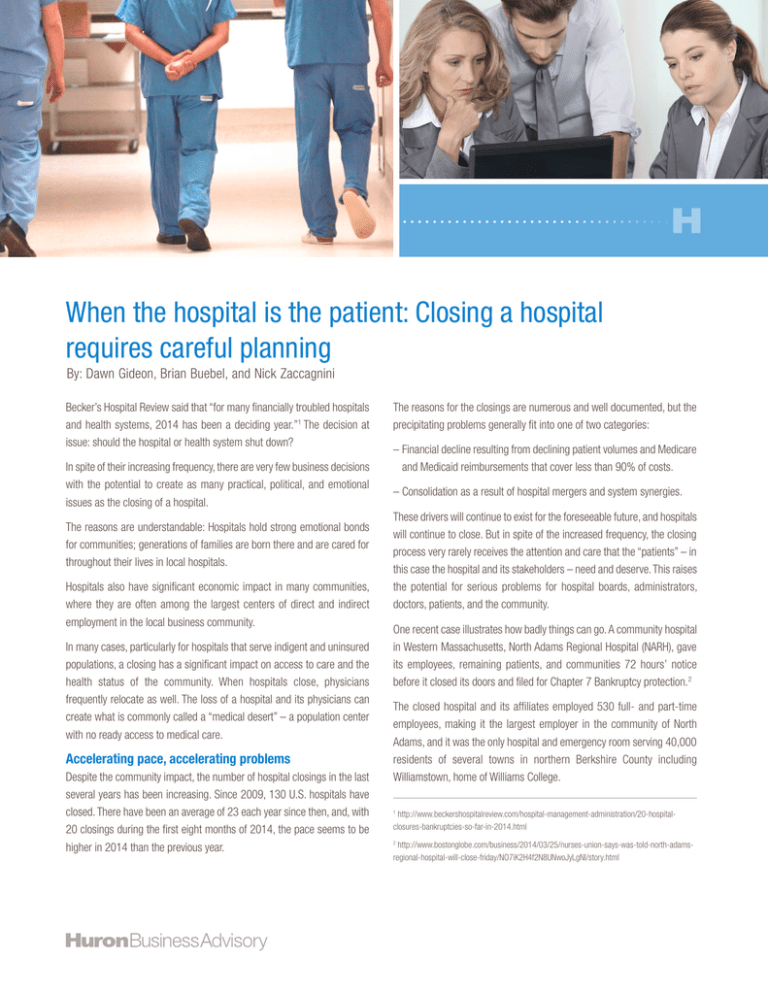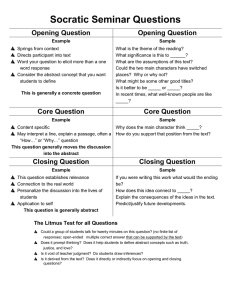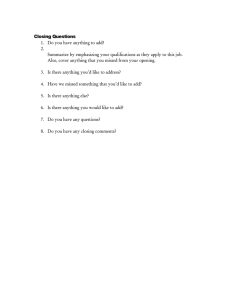
When the hospital is the patient: Closing a hospital
requires careful planning
By: Dawn Gideon, Brian Buebel, and Nick Zaccagnini
Becker’s Hospital Review said that “for many financially troubled hospitals
and health systems, 2014 has been a deciding year.”1 The decision at
issue: should the hospital or health system shut down?
In spite of their increasing frequency, there are very few business decisions
with the potential to create as many practical, political, and emotional
issues as the closing of a hospital.
The reasons are understandable: Hospitals hold strong emotional bonds
for communities; generations of families are born there and are cared for
throughout their lives in local hospitals.
Hospitals also have significant economic impact in many communities,
where they are often among the largest centers of direct and indirect
employment in the local business community.
In many cases, particularly for hospitals that serve indigent and uninsured
populations, a closing has a significant impact on access to care and the
health status of the community. When hospitals close, physicians
frequently relocate as well. The loss of a hospital and its physicians can
create what is commonly called a “medical desert” – a population center
with no ready access to medical care.
Accelerating pace, accelerating problems
Despite the community impact, the number of hospital closings in the last
several years has been increasing. Since 2009, 130 U.S. hospitals have
closed. There have been an average of 23 each year since then, and, with
20 closings during the first eight months of 2014, the pace seems to be
higher in 2014 than the previous year.
The reasons for the closings are numerous and well documented, but the
precipitating problems generally fit into one of two categories:
– Financial decline resulting from declining patient volumes and Medicare
and Medicaid reimbursements that cover less than 90% of costs.
– Consolidation as a result of hospital mergers and system synergies.
These drivers will continue to exist for the foreseeable future, and hospitals
will continue to close. But in spite of the increased frequency, the closing
process very rarely receives the attention and care that the “patients” – in
this case the hospital and its stakeholders – need and deserve. This raises
the potential for serious problems for hospital boards, administrators,
doctors, patients, and the community.
One recent case illustrates how badly things can go. A community hospital
in Western Massachusetts, North Adams Regional Hospital (NARH), gave
its employees, remaining patients, and communities 72 hours’ notice
before it closed its doors and filed for Chapter 7 Bankruptcy protection.2
The closed hospital and its affiliates employed 530 full- and part-time
employees, making it the largest employer in the community of North
Adams, and it was the only hospital and emergency room serving 40,000
residents of several towns in northern Berkshire County including
Williamstown, home of Williams College.
http://www.beckershospitalreview.com/hospital-management-administration/20-hospitalclosures-bankruptcies-so-far-in-2014.html
1
http://www.bostonglobe.com/business/2014/03/25/nurses-union-says-was-told-north-adamsregional-hospital-will-close-friday/NO7iK2H4f2N8UNwoJyLgNI/story.html
2
A nearby hospital group has since purchased certain assets of NARH3, but
the doctors, nurses, and other employees of the hospital; its patients;
community; and other stakeholders have gone through some very trying
times in the months since the surprise announcement was made.
3. Legal and regulatory: Prepare and submit closure plan to state
regulatory agency (department of public health); file required notices
with state pharmacy board; notify federal Drug Enforcement
Administration (DEA); manage pharmacy inventory consistent with DEA
guidelines, both in the pharmacy department and on each floor/
department; notify Nuclear Regulatory Commission; notify accrediting
agencies; notify environmental protection agencies (federal and state);
develop and implement record retention plans.
Planning can ease the process
While the realities of healthcare economics today are likely to continue to
cause additional hospital closings, good planning and seamless
implementation can make the process smoother and provide the care that
the hospital and its stakeholders deserve. Huron Business Advisory has
worked closely with the boards and top management teams of a number
of troubled hospitals to assess and determine the best course of action as
the institution reaches a tipping point.
4. Patient redistribution: Transfer recurring patients to other providers
(wound care, rehab services that will not remain open); work with the
county to determine and finalize its responsibilities under closure;
communicate with local fire/ambulance/police departments;
communicate with all other referral institutions (nursing home, home
health agencies, etc.).
The process will vary, based on the severity of the situation, the status of
any reorganization or restructuring plans, state and local regulatory
requirements, and the timetable for completion. Based on our experience,
we have identified the critical framework of an orderly and wellimplemented plan.
5. Contracts and subleases: Distribute termination notice to payers;
depending on decisions made regarding the need for bankruptcy,
review all contracts and agreements to make a rejection determination.
Elements of a successful closing plan
6. Clinical program closure: Inpatient units should stop elective admissions,
and set a date for closing and transferring all remaining patients;
outpatient services should stop scheduling new patients, and notify and
transfer all appointments after the closing date (except for any
outpatient units that will remain open); surgical services must notify and
transfer all appointments after the closing date, and cannot set
surgeries for after the closing date; set emergency services closing
plan; set plans for closing all ancillary and support services.
The first step in any plan to close a hospital is to set a realistic timetable.
Timing must be driven by cash-flow and other forecasts, and it must
consider a very fundamental question: Is bankruptcy necessary for a
smooth transition to closure?
From that baseline planning forward, the following are the critical areas
that must be addressed, with a specific plan for timing and implementation
of each:
7. Post-closure activities: Must-do’s include mail collection and
distribution; telephone messaging/forwarding; file storage; completion/
closing of medical records and placing records and film into storage;
asset sale or repurposing (supervised if under a bankruptcy process);
resolution of any outstanding resources issues.
1. Human resources: Issues to review include severance analysis;
investigating Worker Adjustment and Retraining Notification Act (WARN)
options, and delivery of the WARN notices, as applicable; decisions on
and contracts for Employee Assistance Programs; scheduling of
meetings and negotiations with unions; development of information for
employees and scheduling of Q&A for all shifts; a review of workers
compensation, retiree benefits plans, etc. with funding strategies;
development of the reduction in force process and timeline;
identification of key employees; and many other must-do’s (copying
and securely storing employee files, for example).
8. Communications: Making sure that all stakeholders are made aware of
the decision to close is critical to the process, and clear communication
may be what determines the success or failure of the plan. A clear and
concise plan for informing all stakeholders throughout the process
must be developed, addressing the information needs of patients,
employees, medical staff, key public officials, and community
stakeholders (such as police, fire, EMS, area nursing homes, and state
medical and hospital associations). Media serving the community are
also key stakeholders, in addition to being a conduit to reach the
community at large. Additional options to communicate the closing of
the hospital include postcard mailings, newspaper notices, hospital
signage, and automated phone calls to residents in the community.
2. Medical staff: Set a plan for a special meeting with the medical
leadership group; notify medical staff of decision, via letter; review any
medical staff bylaws, and determine the process of dissolution of the
organization; establish and execute a plan to retain credentialing files,
and communicate to all staff members; plan for weekly physician
leadership meetings.
3
http://pipeline.thedeal.com/tdd/ViewArticle.dl?id=100051008189
2
huronconsultinggroup.com/business-advisory
Closing a hospital requires careful planning
Clearly, the elements listed here are not intended to serve as the platform
for negotiations leading to the restructuring of a hospital. This plan is
intended to close a hospital in an orderly, transparent, and professional
manner so that disruption can be mitigated to the maximum extent
possible. Negotiation and restructuring will be done at any time around
this process, with or without Court supervision.
About the authors
Dawn Gideon, Managing Director
Dawn has more than 30 years of diverse experience in healthcare
organizational restructuring and turnaround, operations management,
Huron Business Advisory has substantial experience
strategic planning and transactions, marketing, and business development.
Huron has assisted a number of hospitals as they weigh their options
while they deal with the problems of declining patient populations and
lower reimbursements.
She assists organizations in the development and execution of turnaround
Recently, we implemented a closing plan for Palm Drive Hospital in
Sebastopol, California, with elements very similar to those described
above. Instead of an environment of confusion and lack of information,
each stakeholder group was informed fully and in many cases had a
means of asking questions and making comments before and after the
closing took place.
management services, including operational performance improvement,
We facilitated the closing process and held team meetings with
management and department heads, as well as individual meetings with
each department head to guide them through the process and answer any
questions they had. A key takeaway from the Palm Drive Hospital
engagement is the importance of communicating the closure of the
hospital to the community and the stakeholders.
Brian Buebel, Senior Director
Post-closure, we contracted with an EMS organization to keep an
ambulance parked at the emergency room entrance to transport any
patients to nearby hospitals in the event that they were not aware the
hospital had closed. We utilized a variety of communication strategies to
spread awareness of the hospital closing, including newspaper notices,
postcard mailings to all residences in the county, and automated calls to
residents in the community. Additionally, we worked closely with the
Facility Director to place brightly colored signage at the hospital entrances
communicating the hospital closure.
Each case is different and will require a customized approach, but
experienced professionals can mean the difference between a free-fall
and a soft-landing when a hospital closes.
businessadvisory@huronconsultinggroup.com
huronconsultinggroup.com/business-advisory
© 2015 Huron Consulting Group Inc. All Rights Reserved. Huron is a management consulting firm and not a CPA firm, and does not
provide attest services, audits, or other engagements in accordance with standards established by the AICPA or auditing standards
promulgated by the Public Company Accounting Oversight Board (“PCAOB”). Huron is not a law firm; it does not offer, and is not
authorized to provide, legal advice or counseling in any jurisdiction.
and restructuring plans within and outside of bankruptcy, serving as both
advisor and interim chief executive officer of hospitals and health systems
moving through management transition. She provides consulting and
program development, strategic planning, and merger and acquisition
advisory services to hospitals, post-acute care providers, healthcare systems,
and physician practices. Dawn also delivers advisory services to healthcare
lenders regarding troubled credits. Dawn can be reached at 646-277-8818
or dgideon@huronconsultinggroup.com.
Brian has nearly 20 years of experience in corporate turnarounds,
bankruptcy, loan workouts, financial advisory, and corporate finance. He has
experience in a wide variety of industries, including healthcare, life sciences,
transportation, shipping, air transport, financial services, automotive, textiles,
manufacturing, telecommunications, and technology. Brian can be reached
at 646-277-2212 or bbuebel@huronconsultinggroup.com.
Nick Zaccagnini, Director
Nick has more than 10 years of experience in corporate restructuring and
turnaround activity advising public and privately held companies. He is
a Certified Insolvency and Restructuring Advisor (“CIRA”) and a Certified
Turnaround Analyst (“CTA”). His healthcare experience includes evaluating
and stress testing the financial model and financial modeling capabilities of a
large hospital system, representing the Unsecured Creditors’ Committee for a
community hospital in a Chapter 11 case, assisting a district owned hospital
in developing a financial model and a Confidential Information Memorandum
to execute its strategic turnaround plan, and managing another district
owned hospital through its closure and Chapter 9 case. Nick can be reached
at 312-880-3252 or nzaccagnini@huronconsultinggroup.com.



